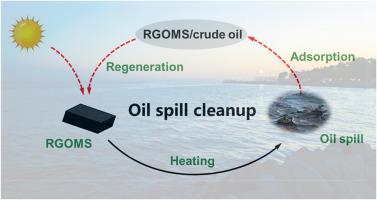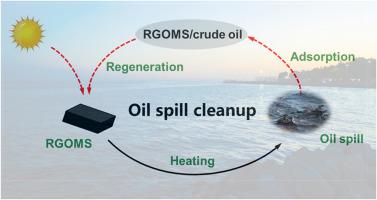An industrializable recovery technology for marine oil spill based on solar-thermal adsorption material
IF 10
1区 环境科学与生态学
Q1 ENGINEERING, ENVIRONMENTAL
引用次数: 0
Abstract
Photothermal oil-absorbing materials offer significant benefits for marine oil spill treatment thanks to their high efficiency, environmental friendliness, and reusability. However, expensive treatment costs and a fragmented process flow have restricted their large-scale practical application. To address these issues and facilitate the transition of photothermal oil-absorbing materials to real-world use, an integrated, low-cost, and high-efficiency process was proposed for marine oil spill cleanup. This integrated process comprises three key components, i.e., preparation of photothermal adsorption materials, photothermal adsorption of oil spills, and regeneration-reuse of photothermal materials. A graphene-coated melamine sponge (RGOMS) with minimized cost was prepared. Oil spill recovery experiments were then carried out using the prepared material. RGOMS exhibits superior photothermal-adsorption capacity for crude oil, adsorbing 74.69 times its own mass in 19 min, The oil-laden RGOMS was finally underwent an inexpensive regeneration method, i.e., “n-stage staggered-flow cleaning” strategy to enhance cleaning efficiency (99.47 %) and further reduce costs (54.55 %). This integrated oil spill cleanup process demonstrates unique advantages such as high efficiency and low cost, providing a model and guidance for the practical application of photothermal oil-absorbing materials.


基于光热吸附材料的海洋溢油产业化回收技术
光热吸油材料因其高效、环保和可重复使用的特点,为海洋溢油处理提供了重要的优势。然而,昂贵的处理成本和分散的工艺流程限制了它们的大规模实际应用。为了解决这些问题并促进光热吸油材料向实际应用的过渡,提出了一种集成的、低成本的、高效的海洋溢油清理工艺。该综合工艺包括光热吸附材料制备、光热吸附溢油、光热材料再生再利用三个关键环节。制备了成本最低的石墨烯包覆三聚氰胺海绵(RGOMS)。然后利用制备的材料进行溢油回收试验。RGOMS对原油表现出优异的光热吸附能力,在19 min内吸附其自身质量的74.69倍。最后,采用廉价的再生方法,即“n级混流清洗”策略,提高了清洗效率(99.47%),进一步降低了成本(54.55%)。该综合溢油清理工艺具有高效、低成本等独特优势,为光热吸油材料的实际应用提供了模型和指导。
本文章由计算机程序翻译,如有差异,请以英文原文为准。
求助全文
约1分钟内获得全文
求助全文
来源期刊

Journal of Cleaner Production
环境科学-工程:环境
CiteScore
20.40
自引率
9.00%
发文量
4720
审稿时长
111 days
期刊介绍:
The Journal of Cleaner Production is an international, transdisciplinary journal that addresses and discusses theoretical and practical Cleaner Production, Environmental, and Sustainability issues. It aims to help societies become more sustainable by focusing on the concept of 'Cleaner Production', which aims at preventing waste production and increasing efficiencies in energy, water, resources, and human capital use. The journal serves as a platform for corporations, governments, education institutions, regions, and societies to engage in discussions and research related to Cleaner Production, environmental, and sustainability practices.
 求助内容:
求助内容: 应助结果提醒方式:
应助结果提醒方式:


